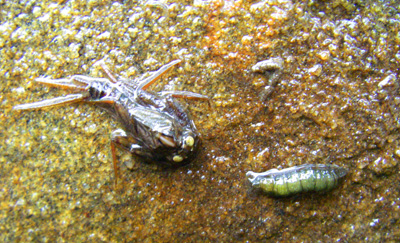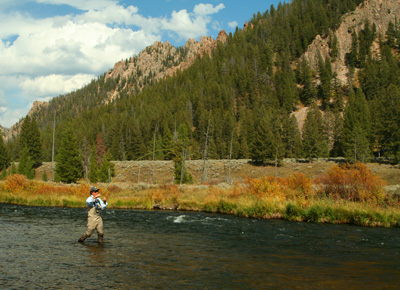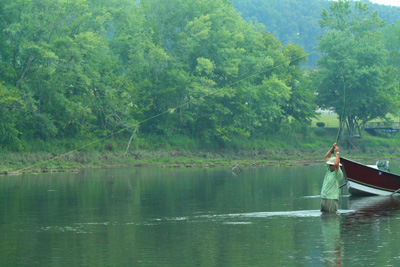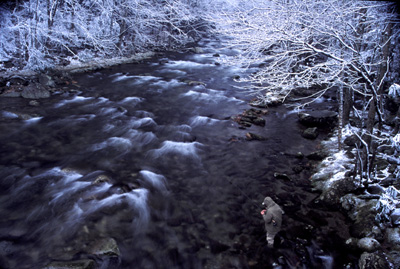Fly fishing with dropper rigs is one of the most effective methods for catching trout with flies. First, it allows a fly fisher to fish two different fly patterns which doubles your chances of fishing the right fly at the right time. Second, it makes it possible to have a fly in two places at once.
Mayfly nymphs and caddis larva can be in the same place at the same time. Doesn’t it make sense to fish the same way?
We rig droppers two different ways depending on the situation. The most popular rig for droppers is the “dry and dropper”. This is when the fly fisher uses a dry fly, then attaches a wet fly or nymph underneath. This allows the dry fly to act as a strike indicator in addition to being an effective fly on the surface.
We rig this by tying a second piece of tippet to the bend of the hook of the dry fly. This is accomplished with a simple clinch knot. The wet fly or nymph is then tied onto the additional tippet. Use at least 12″ of line, perhaps more depending on the water you are fishing. Depending on the situation it may be appropriate to use 24″ – 36″ of tippet to separate the dry and nymph.
There are a few things to consider when rigging the dry and dropper. Be sure your dry fly is big enough and bushy enough to support the second fly. Second, your nymph or wet fly must not be too heavy to sink your dry fly. We recommend Stimulators and Wulff patterns in a #12 or #14 for streams in the Smokies. Our favorite droppers under these dry flies are #16 Copper Johns and Beadhead Pheasant Tail Nymphs.
Sign up for Informative Articles and Fishing Reports
![]()
On the tailwaters we like to use Zebra Midges, soft hackles, or unweighed Pheasant Tail Nymphs under an appropriate caddis or mayfly dry fly. Small dry fly patterns used on Southern tailwaters won’t hold up much weight, but we’re often casting dries to risers anyway. Many of these rising trout are eating emergers just under the surface so weight isn’t required anyway. Comparaduns are superb dry flies in their own right, but will easily support a small midge pupa or unweighted Pheasant Tail Nymph. Elk Hair Caddis are also good choices on rivers with good caddis populations. Pair them with caddis pupa, soft hackles, or small Hare’s Ears or Pheasant Tails.
Perhaps the most popular Western dropper rig is the “Hopper Dropper”. This rig uses a large dry fly that imitates a grasshopper with any of a variety of nymph patterns. Serendipities are popular to use on the Madison, but a nymph that imitates any insect that’s in season to hatch will work on any river. A #16 Beadhead Pheasant Tail or Hare’s Ear is about as universal a pattern as you’re likely to find. You can also make this an all out attractor rig by going with the “Hopper Copper Dropper”. This uses a foam dry fly in the tradition of a Chernobyl Ant or Hopper with a Copper John. Some will even tie on an additional nymph that is more in the “match the hatch” tradition. That is, the large foam dry and glittery Copper John will get a fish’s eye, but the third fly should seal the deal for picky fish.
The “Hopper Dropper” is popular on Western RiversÂ
Fishing with Two Nymphs
The second type of dropper rig we use is with two nymphs or wets. We try to make the two nymphs pretty different. In the Smokies we’ll use a Beadhead Hare’s Ear or Pat’s Nymph fished with a Beadhead Pheasant Tail or Copper John. These flies are all about the same size, #14 or #16, but have different color schemes. A Hare’s Ear Nymphs and Pat’s Nymphs are both dull colored, tan or gray, flies. A Pheasant Tail Nymph is darker and a Copper John has a lost of flash.
Another way we present nymphs for variety is by using a large nymph with a smaller one. We’ll fish a bigger stonefly nymph patterns in tandem with a smaller beadhead. Our favorites are a #8-10 Tellico Nymph or #10-12 Prince Nymph fished with a #14-16 Beadhead Pheasant Tail, Pat’s Nymph, or Copper John.
Using two flies at once is a quicker way to discover the best fly to use for picky tailwater trout
The tailwaters call for a slight variation. A #18-20 Zebra Midge paired with a #16 Beadhead Pheasant Tail is the combination we use most frequently. In our opinion, a Pheasant Tail will pick up fish in at least 50% or more of the situations we see on the tailwaters, so it’s on our line more than idling in a fly box.
The way we usually rig our nymph droppers is different from the dry and dropper. We take the top fly and slide it on up the leader at least 12″, often further, then tie a clinch knot. This leaves a long tag of tippet which we use to tie on the bottom fly. This method leaves both hooks completely open and unobstructed.
Fishing with two weighted nymphs can provide more weight to reach sluggish fish when the water is cold
In the Smokies we usually put the heavier fly on bottom. Smoky Mountain trout holding in swift water are not tippet shy so we’ll 3X or 4X tippet in this situation. In the high flows of spring we’ll fish a #12 Beadhead Pheasant Tail or other similar size nymph on top with a stonefly pattern on bottom. This puts the stonefly pattern near the bottom where it belongs while the mayfly or caddis imitation is higher in the water column as if it’s ascending to the surface. We use #8 – 10 Tellico Nymphs or #10 – 12 Prince Nymphs most often for this rig. Heavier leaders and tippet help turn these heavy rigs over better than light line. Anglers are also far more likely to get their flies back using heavy tippet when they inevitably snag the bottom.
On the tailwaters we usually put the heavier fly on top so it sinks the smaller one as well. Tailwater trout are far less likely to go out of their way for food since they’re pretty well fed. Getting both flies down deep is important if fish aren’t actively rising. This is also important when you’re fishing a #16 Beadhead Pheasant Tail and have it paired with a #20 Zebra Midge. A smaller fly often requires the use of finer tippet. Also, using finer tippet helps your cast by continuing the taper of the leader. You can tie the finer tippet to the bend of the top hook. Another option is to tie the extra tippet to the eye of the larger hook. Large hook eyes will often have more than enough room for some fine tippet.
 Sign up for Informative Articles and Fishing Reports
![]()



